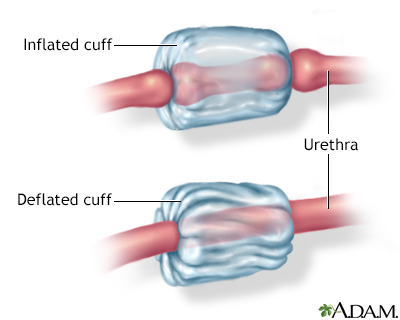Inflatable artificial sphincter - series

Normal anatomy
Urinary continence is maintained by a muscular sphincter that surrounds the urethra as it exits the bladder.

Procedure, part 1
An artificial urinary sphincter is used to treat stress incontinence in men that is caused by urethral dysfunction such as after prostate surgery. Additionally this procedure may be performed in men and women with sphincter dysfunction related to spinal cord injury or multiple sclerosis. Most experts advise their patients to try medication and bladder retraining therapy first before resorting to this treatment. Alternatives to this procedure are the pubovaginal sling in women or the periurethral injection of bulking agents in men and women.

Procedure, part 2
An artificial sphincter consists of three parts:
- A cuff that fits around the bladder neck
- A pressure regulating balloon
- A pump that inflates the cuff
To treat urinary incontinence, the cuff is placed around the bladder neck so that when it is inflated, the urethra will close tightly. The pressure regulating balloon will be placed under the tissues of the lower abdomen. The balloon is filled with a liquid (occasionally, an iodine-based solution will be used so that it will be visualized when x-ray procedures are performed).
The control pump mechanism is placed in the labia for women, and in the scrotum for men. To use the sphincter, the person will compress (squeeze) the pump to divert fluid from the urethral cuff to the balloon. This action will allow the sphincter to relax so that the person can urinate. The cuff will then re-inflate on its own in 1 to 2 minutes.

Procedure, part 3
When inflated, the cuff constricts the urethra and blocks passage of any urine. When deflated, the cuff reduces pressure on the urethra and allows for free passage of urine.

Aftercare
If you had an artificial urinary sphincter placed, you might return from surgery with a Foley catheter in place, which will be removed prior to discharge. The artificial sphincter cuff will be not be inflated immediately after surgery to allow the tissues to heal. About 6 weeks after surgery you will be taught how to activate your pump to inflate the artificial sphincter.
BACK TO TOP
Review Date: 5/17/2024
Reviewed By: Sovrin M. Shah, MD, Associate Professor, Department of Urology, The Icahn School of Medicine at Mount Sinai, New York, NY. Review provided by VeriMed Healthcare Network. Also reviewed by David C. Dugdale, MD, Medical Director, Brenda Conaway, Editorial Director, and the A.D.A.M. Editorial team.

Health Content Provider
06/01/2025
|
A.D.A.M., Inc. is accredited by URAC, for Health Content Provider (www.urac.org). URAC's accreditation program is an independent audit to verify that A.D.A.M. follows rigorous standards of quality and accountability. A.D.A.M. is among the first to achieve this important distinction for online health information and services. Learn more about A.D.A.M.'s editorial policy, editorial process and privacy policy. A.D.A.M. is also a founding member of Hi-Ethics. This site complied with the HONcode standard for trustworthy health information from 1995 to 2022, after which HON (Health On the Net, a not-for-profit organization that promoted transparent and reliable health information online) was discontinued. |
The information provided herein should not be used during any medical emergency or for the diagnosis or treatment of any medical condition. A licensed medical professional should be consulted for diagnosis and treatment of any and all medical conditions. Links to other sites are provided for information only -- they do not constitute endorsements of those other sites. © 1997- 2025 A.D.A.M., a business unit of Ebix, Inc. Any duplication or distribution of the information contained herein is strictly prohibited.
